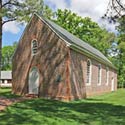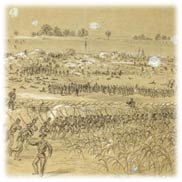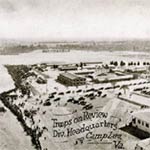History of Prince George County, Virginia
 Prince George County was named for Prince George of Denmark, the husband of England's Queen Anne. The county was formed from the part of Charles City County (then a Shire) that was divided by the James River. From May 1607 until 1613, the area that would become Prince George County was a corporation of the Virginia Company. Monthly courts were held on this land from about 1623 until it became inconvenient for the settlers on the south side of the James River to make the water crossing. In August of 1702 the General Assembly declared the lands of Charles City County on the south side of the river to be Prince George County. After the General Assembly action, the County officially was established in July of 1703. Prince George County was named for Prince George of Denmark, the husband of England's Queen Anne. The county was formed from the part of Charles City County (then a Shire) that was divided by the James River. From May 1607 until 1613, the area that would become Prince George County was a corporation of the Virginia Company. Monthly courts were held on this land from about 1623 until it became inconvenient for the settlers on the south side of the James River to make the water crossing. In August of 1702 the General Assembly declared the lands of Charles City County on the south side of the river to be Prince George County. After the General Assembly action, the County officially was established in July of 1703.
Prince George County is located 30 miles south of Richmond, the capital of the Commonwealth of Virginia. It is bordered on the north by Hopewell and the Appomattox and James Rivers, on the east by Surry County, on the south by Sussex County, and on the west by Petersburg and Dinwiddie County. Captain Christopher Newport visited the area in May 1607 while looking for a permanent settlement location for the English colonists. It was along the James River that there were substantial land grants from the British monarch to establish settlements. One of the original Jamestown settlers, John Martin, received a large land grant, Martin’s Brandon, in 1616. A home built by the Harrison family (Benjamin V) in the mid -eighteenth century still stands today on Brandon with architectural features that strongly suggest Jeffersonian influence. Sir George Yeardley established Flowerdew Hundred in 1619. It was here that three distinct and diverse cultures came together when the first Africans arrived at Flowerdew Hundred, joining European settlers and the indigenous Indians: tribes of the Weyanoke, Appomattox, and Tappahanna of the Powhatan Nation. It was also at Flowerdew Hundred that the first windmill was established in North America. In 1620, a fortified settlement at Jordan’s Journey/Point by Samuel Jordan provided a haven for the survivors of the massacre of 1622. It was also the site of the first breach of promise suit in North America: the Rev. Griville Pooley vs. the widowed Cecily Jordan in 1623.
 Martin’s Brandon Parish Church, today located in the village of Burrowsville, traces its beginnings to the Brandon land grant, or earlier, and to a small cemetery on the plantation known as Church Pastures. The first minister arrived in1618. The Church possesses communion silver from its earliest days. The first two Church sites were likely on the site along the river. The third site was in the village of Burrowsville, across from today’s Church structure, at or near the School’s location. The 1856 Church building remains in use today. Martin’s Brandon Parish Church, today located in the village of Burrowsville, traces its beginnings to the Brandon land grant, or earlier, and to a small cemetery on the plantation known as Church Pastures. The first minister arrived in1618. The Church possesses communion silver from its earliest days. The first two Church sites were likely on the site along the river. The third site was in the village of Burrowsville, across from today’s Church structure, at or near the School’s location. The 1856 Church building remains in use today.
Merchant’s Hope Church, a parish that was established in 1657 and whose current building of Flemish bond, dates to 1743 was named for a ship  that sailed in 1635 from Gravesend, England and a subsequent plantation that was established here. The parish possesses a 1639 New Testament attached to a 1640 Old Testament. In 1974, the parish accepted a gift of an authentic English Tetragrammaton which it restored to hang above the altar. That early representation of Jehovah is believed to be the only one in existence in North America. that sailed in 1635 from Gravesend, England and a subsequent plantation that was established here. The parish possesses a 1639 New Testament attached to a 1640 Old Testament. In 1974, the parish accepted a gift of an authentic English Tetragrammaton which it restored to hang above the altar. That early representation of Jehovah is believed to be the only one in existence in North America.
The town of Blandford (established in 1748) was originally a part of the County as was Petersburg. Blandford Church was built from 1735-1737 within what was then called Bristol Parish (formed in 1643). The church and its historic cemetery are now a historic site and visitors’ center that offers a tour that includes fifteen Louis Comfort Tiffany stained glass windows. It was annexed to Petersburg in 1971.
In 1752, Dinwiddie County was created, and contained part of what had been western Prince George County. Petersburg became part of Dinwiddie County at this time. During the Revolutionary War, British forces under Major General William Phillips marched through Prince George County to attack Americans defending Petersburg on April 25, 1781. The victorious British commander of this battle died in Petersburg on May 13. He was buried in the Blandford Church Cemetery in an unmarked grave.
The American Civil War forever changed the County of Prince George. Farmlands were neglected and abandoned as the County’s sons went to war. An agricultural innovator and committed secessionist, Edmund Ruffin was born at Evergreen on the James River, in 1794. . Although his agricultural contributions saved many of the farms with his concept of replenishing soils rather than depleting them, Ruffin remains known as the person behind the first shot at Fort Sumter and the beginning of the War. Even if, as many historians believe, that was not the case, no one could argue against his blatant support of the war effort. He died of suicide at the war’s end. . Although his agricultural contributions saved many of the farms with his concept of replenishing soils rather than depleting them, Ruffin remains known as the person behind the first shot at Fort Sumter and the beginning of the War. Even if, as many historians believe, that was not the case, no one could argue against his blatant support of the war effort. He died of suicide at the war’s end.
Confederate leaders understood the military importance of Petersburg early in the war. Work to construct fortifications to defend the city began in 1862 under Captain Charles H. Dimmock. Ten miles of entrenchments, including 55 artillery batteries, ringed the city on its east, south, and west with many of them in Prince George County. From June 15-17, 1864 approximately 40% of the Army of the Potomac crossed the James River on a 2100-foot long pontoon bridge from Weyanoke Point in Charles City County to Windmill Point at Flowerdew Hundred Plantation. The movement of much of the Army of the Potomac to a location south of the James River served to end the 1864 Overland Campaign and to begin the campaign of Petersburg//Richmond. Many battles occurred in the County during the siege of Petersburg.  Among the 1864 battles were Baylor’s Farm (in present-day Hopewell) on June 15, Jerusalem Plank Road from June 21-24, Reams Station on August 25, and Confederate General Wade Hampton’s Beefsteak Raid from September 15-18. Among the 1864 battles were Baylor’s Farm (in present-day Hopewell) on June 15, Jerusalem Plank Road from June 21-24, Reams Station on August 25, and Confederate General Wade Hampton’s Beefsteak Raid from September 15-18.
Volunteers dug a tunnel 511 feet long under the Confederate earthwork known as Elliott’s Salient, and exploded 8000 pounds of gunpowder. The subsequent Union attack failed to break through the Confederate lines protecting Petersburg. The Battle of Fort Stedman, Lee’s last grand offensive, was fought on March 25, 1865. One week after this battle, the Union forces penetrated the Confederate entrenchments outside of Petersburg. Seven days later, Lee surrendered at Appomattox Court House. In all, elements of the Union Army of the Potomac and the Confederate Army of Northern Virginia were in Prince George County from June 9, 1864 until April 3, 1865 during the Petersburg Campaign. It was the longest siege in American history. The Petersburg National Battlefield was authorized by Congress in 1926 and is today a major visitation point within the National Park Service. Only a small portion of the Park remains within the Prince George County geographical boundaries.
The conclusion of the American Civil War brought many changes to the County. Former slaves of the plantation system were freed and the county’s social, political, and economic systems changed. Many churches were founded during the remainder of the 19th century, particularly for black congregations, among them Harrison Grove (1865), Pleasant Grove (1865), and Morning Star (1885). Peter Randolph, born to slavery at Brandon and freed upon the death of his owner,  went on to become a famous preacher and author including his writing entitled “Sketches of Slave Life”. went on to become a famous preacher and author including his writing entitled “Sketches of Slave Life”.
In the late 19th century Prince George County’s public school system
began, a system that was segregated until the 1960’s. One room schools were common, some with multi grade levels. Burrowsville and Disputanta had early high schools for white students. Disputanta also had a black high school, the Disputanta Training School. In addition, the County was the site of five Rosenwald Schools, a system of the early 1900’s funded largely by the then President of Sears Roebuck, Julius Rosenwald , to educate black children in the South. In 1953 the Prince George School was opened that offered white children an education for grades 1-12. Three years later, 1956, J.E. J. Moore School opened as school for black students, grades 1 through 11. In 1964 the two schools merged to create an integrated high School and J.E.J. Moore became the County’s junior high.
 Between 1888 and 1920, more than three hundred families
from Eastern Europe came to Prince George- to farmlands devastated and abandoned after the War. Their efforts helped revitalize agriculture in the County. These immigrants brought with them the rich Slavic culture of their homelands. In 2012, the Church of the Sacred Heart in New Bohemia was placed on the National Register of Historic Places in recognition of its long-standing representation of the culture and faith brought here by the Slavs. Begonia Church, now Bethlehem Congregational, is believed to be the earliest Slovak Church in the South. Prince George County is home to the annual Virginia Czech and Slovak Folklife Festival in October. The immigration story is an important part of the heritage of Prince George County that is told in a 2016 permanent addition to the Heritage Center. Between 1888 and 1920, more than three hundred families
from Eastern Europe came to Prince George- to farmlands devastated and abandoned after the War. Their efforts helped revitalize agriculture in the County. These immigrants brought with them the rich Slavic culture of their homelands. In 2012, the Church of the Sacred Heart in New Bohemia was placed on the National Register of Historic Places in recognition of its long-standing representation of the culture and faith brought here by the Slavs. Begonia Church, now Bethlehem Congregational, is believed to be the earliest Slovak Church in the South. Prince George County is home to the annual Virginia Czech and Slovak Folklife Festival in October. The immigration story is an important part of the heritage of Prince George County that is told in a 2016 permanent addition to the Heritage Center.
Major historical developments in the county during the past century included the incorporation of Hopewell in 1916 and the almost simultaneous establishment of Camp Lee. The new city of Hopewell, in 1923, annexed historic City Point, and industry thrived with the establishment of new chemical plants in the city. In June 1917, soon after American entry into World War I,  Camp Lee was established on 8900 acres of Prince George County. After the war the camp became dormant, but in October 1940 survey work began on reopening the post for World War II. In 1952 the camp became permanent and was renamed Fort Lee. In 2005’s Base Realignment and Closure (BRAC)the post more than doubled in population and today the post trains more than 70,000 troops a year. Camp Lee was established on 8900 acres of Prince George County. After the war the camp became dormant, but in October 1940 survey work began on reopening the post for World War II. In 1952 the camp became permanent and was renamed Fort Lee. In 2005’s Base Realignment and Closure (BRAC)the post more than doubled in population and today the post trains more than 70,000 troops a year.
Recent industrial development within the County includes the opening of Southpoint Industrial Park in1997. In 2011, Rolls Royce began production of precision jet engine parts at its facility known as Crosspointe. The Commonwealth Center for Advanced Manufacturing (CCAM) located on the campus of Crosspointe brings applied research to its global members, including Rolls Royce, in a state of the art facility. CCAM opened in 2013.
 On June 4, 2003 the Department of the Interior and the Department of Historic Resources created the Prince George County Courthouse Historic District. The district contains the 1883 Courthouse, ten other buildings, and three objects. The restored and renovated Courthouse along with its historic Clerk’s Office house the Prince George County Regional Heritage Center. A third building, the historic Jail, will be added to the Heritage Center in the near future as the Fire and EMS Museum. On June 4, 2003 the Department of the Interior and the Department of Historic Resources created the Prince George County Courthouse Historic District. The district contains the 1883 Courthouse, ten other buildings, and three objects. The restored and renovated Courthouse along with its historic Clerk’s Office house the Prince George County Regional Heritage Center. A third building, the historic Jail, will be added to the Heritage Center in the near future as the Fire and EMS Museum.
|





